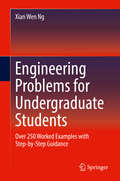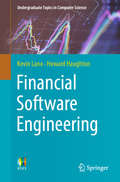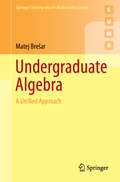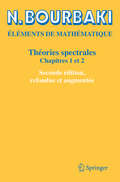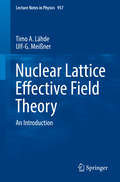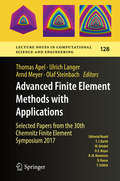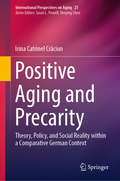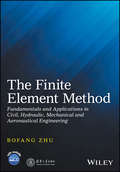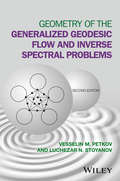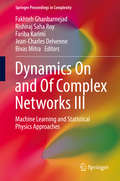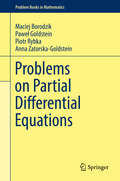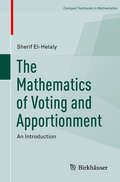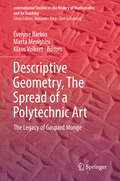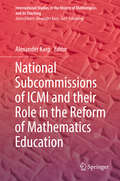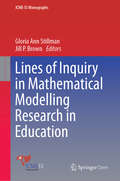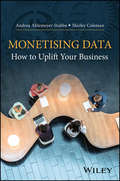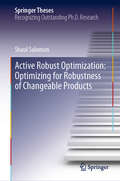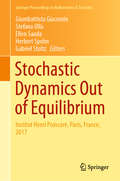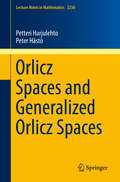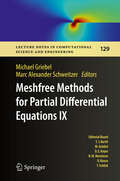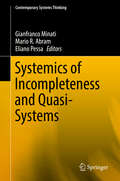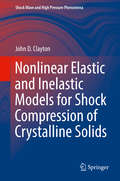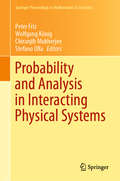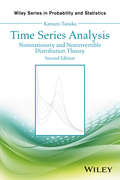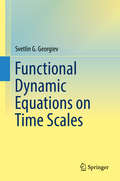- Table View
- List View
Engineering Problems for Undergraduate Students: Over 250 Worked Examples with Step-by-Step Guidance
by Xian Wen NgThis textbook supplement deconstructs some of the most commonly-encountered and challenging problems arising within engineering domains such as thermodynamics, separation processes, chemical kinetics, fluid dynamics, and engineering mathematics that are foundational to most engineering programs, as well as many courses in STEM disciplines. The book is organized into a series of 250 problems and worked solutions, with problems written in a format typical of exam questions. The book provides students ample practice in solving problems and sharpening their skill applying abstract theoretical concepts to solving exam problems. The presentation of detailed step-by-step explanations for each problem from start to finish in this book helps students follow the train of thought toward arriving at the final numerical solutions to the problems.Stands as an all-in-one, multidisciplinary, engineering problem-solving resource with comprehensive depth and breadth of coverage;Adopts a highly relevant question and answer pedagogy;Maximizes understanding through clear use of visuals;Emphasizes detailed, step-by-step explanations;Includes supplementary sections of cross-referenced concepts.
Financial Software Engineering (Undergraduate Topics in Computer Science)
by Kevin Lano Howard HaughtonIn this textbook the authors introduce the important concepts of the financial software domain, and motivate the use of an agile software engineering approach for the development of financial software. They describe the role of software in defining financial models and in computing results from these models. Practical examples from bond pricing, yield curve estimation, share price analysis and valuation of derivative securities are given to illustrate the process of financial software engineering.Financial Software Engineering also includes a number of case studies based on typical financial engineering problems:*Internal rate of return calculation for bonds* Macaulay duration calculation for bonds* Bootstrapping of interest rates* Estimation of share price volatility* Technical analysis of share prices* Re-engineering Matlab to C#* Yield curve estimation* Derivative security pricing* Risk analysis of CDOs The book is suitable for undergraduate and postgraduate study, and for practitioners who wish to extend their knowledge of software engineering techniques for financial applications
Undergraduate Algebra: A Unified Approach (Springer Undergraduate Mathematics Series)
by Matej BrešarThis textbook offers an innovative approach to abstract algebra, based on a unified treatment of similar concepts across different algebraic structures. This makes it possible to express the main ideas of algebra more clearly and to avoid unnecessary repetition.The book consists of two parts: The Language of Algebra and Algebra in Action. The unified approach to different algebraic structures is a primary feature of the first part, which discusses the basic notions of algebra at an elementary level. The second part is mathematically more complex, covering topics such as the Sylow theorems, modules over principal ideal domains, and Galois theory.Intended for an undergraduate course or for self-study, the book is written in a readable, conversational style, is rich in examples, and contains over 700 carefully selected exercises.
Théories spectrales: Chapitres 1 et 2
by N. BourbakiLes Éléments de mathématique de Nicolas BOURBAKI ont pour objet une présentation rigoureuse, systématique et sans prérequis des mathématiques depuis leurs fondements.Le Livre de Théories spectrales est consacré à l'étude des algèbres normées et de leurs applications. Le premier chapitre met en place la théorie fondamentale des algèbres de Banach et des algèbres stellaires. Nous y présentons l'équivalence de catégories entre algèbres stellaires commutatives et espaces topologiques localement compacts, ainsi que le calcul fonctionnel holomorphe en plusieurs variables dans une algèbre de Banach commutative. La transformation de Fourier, qui est l'un des outils mathématiques les plus universels, est étudiée au second chapitre, dans le cadre des groupes localement compacts commutatifs. Le texte est complété par de nombreux exercices. Ces deux chapitres forment une édition entièrement refondue de l'édition de 1967. The Elements of Mathematics of Nicolas Bourbaki have the goal of giving a rigorous and systematic presentation of mathematics starting from the foundations, without prerequisites. The book of Spectral Theories is devoted to the study of normed algebras and their applications. The first chapter establishes the basic theory of Banach algebras and C*-algebras. We present the equivalence of categories between commutative C*-algebras and locally compact topological spaces, as well as the holomorphic functional calculus in several variables in a commutative Banach algebra.The Fourier transform, which is one of the most universal mathematical tools, is studied in the second chapter, in the context of locally compact commutative topological groups.The text is accompanied by many exercices.These two chapters are completely updated new versions of the 1967 original edition.
Nuclear Lattice Effective Field Theory: An Introduction (Lecture Notes in Physics #957)
by Timo A. Lähde Ulf-G. MeißnerThis primer begins with a brief introduction to the main ideas underlying Effective Field Theory (EFT) and describes how nuclear forces are obtained from first principles by introducing a Euclidean space-time lattice for chiral EFT. It subsequently develops the related technical aspects by addressing the two-nucleon problem on the lattice and clarifying how it fixes the numerical values of the low-energy constants of chiral EFT. In turn, the spherical wall method is introduced and used to show how improved lattice actions render higher-order corrections perturbative. The book also presents Monte Carlo algorithms used in actual calculations. In the last part of the book, the Euclidean time projection method is introduced and used to compute the ground-state properties of nuclei up to the mid-mass region. In this context, the construction of appropriate trial wave functions for the Euclidean time projection is discussed, as well as methods for determining the energies of the low-lying excitations and their spatial structure. In addition, the so-called adiabatic Hamiltonian, which allows nuclear reactions to be precisely calculated, is introduced using the example of alpha-alpha scattering. In closing, the book demonstrates how Nuclear Lattice EFT can be extended to studies of unphysical values of the fundamental parameters, using the triple-alpha process as a concrete example with implications for the anthropic view of the Universe. Nuclear Lattice Effective Field Theory offers a concise, self-contained, and introductory text suitable for self-study use by graduate students and newcomers to the field of modern computational techniques for atomic nuclei and nuclear reactions.
Advanced Finite Element Methods with Applications: Selected Papers from the 30th Chemnitz Finite Element Symposium 2017 (Lecture Notes in Computational Science and Engineering #128)
by Thomas Apel Ulrich Langer Arnd Meyer Olaf SteinbachFinite element methods are the most popular methods for solving partial differential equations numerically, and despite having a history of more than 50 years, there is still active research on their analysis, application and extension. This book features overview papers and original research articles from participants of the 30th Chemnitz Finite Element Symposium, which itself has a 40-year history. Covering topics including numerical methods for equations with fractional partial derivatives; isogeometric analysis and other novel discretization methods, like space-time finite elements and boundary elements; analysis of a posteriori error estimates and adaptive methods; enhancement of efficient solvers of the resulting systems of equations, discretization methods for partial differential equations on surfaces; and methods adapted to applications in solid and fluid mechanics, it offers readers insights into the latest results.
Positive Aging and Precarity: Theory, Policy, and Social Reality within a Comparative German Context (International Perspectives on Aging #21)
by Irina Catrinel CrăciunThis book explores positive aging through the lens of precarity, aiming to ground positive aging theories in current social contexts. In recent years, research on aging has been branded by growing disagreements between supporters of the successful aging model and critical gerontologists who highlight the widening inequalities, disadvantages and precarity that characterize old age. This book comes to fill a gap in knowledge by offering an alternative view on positive aging, informed by precarity and its impact on projections concerning aging.The first part of the book places aging in broader theoretical and empirical context, exploring the complex links between views on aging, successful aging theories, policy and social reality. The second part uses results from a qualitative research conducted in Germany to illustrate the dissonance between successful aging ideals and both negative and positive views on aging as well as aging preparation strategies inspired by precarity. Findings from this section provide a solid starting point for comparisons with countries that are both similar and different from Germany in terms of welfare regimes and aging policies. The final part of the book discusses the psychological implications of these findings within and beyond the German case study and outlines potential solutions for practice. This book provides health psychologists, gerontologists, sociologists, social workers, health professionals as well as students and aging individuals themselves with better understanding of the meaning of aging in precarious times and builds confidence about aging well despite precarity.
The Finite Element Method: Fundamentals and Applications in Civil, Hydraulic, Mechanical and Aeronautical Engineering
by ZhuA comprehensive review of the Finite Element Method (FEM), this book provides the fundamentals together with a wide range of applications in civil, mechanical and aeronautical engineering. It addresses both the theoretical and numerical implementation aspects of the FEM, providing examples in several important topics such as solid mechanics, fluid mechanics and heat transfer, appealing to a wide range of engineering disciplines. Written by a renowned author and academician with the Chinese Academy of Engineering, The Finite Element Method would appeal to researchers looking to understand how the fundamentals of the FEM can be applied in other disciplines. Researchers and graduate students studying hydraulic, mechanical and civil engineering will find it a practical reference text.
Geometry of the Generalized Geodesic Flow and Inverse Spectral Problems
by Vesselin M. Petkov Luchezar N. StoyanovThis book is a new edition of a title originally published in1992. No other book has been published that treats inverse spectral and inverse scattering results by using the so called Poisson summation formula and the related study of singularities. This book presents these in a closed and comprehensive form, and the exposition is based on a combination of different tools and results from dynamical systems, microlocal analysis, spectral and scattering theory.The content of the first edition is still relevant, however the new edition will include several new results established after 1992; new text will comprise about a third of the content of the new edition. The main chapters in the first edition in combination with the new chapters will provide a better and more comprehensive presentation of importance for the applications inverse results. These results are obtained by modern mathematical techniques which will be presented together in order to give the readers the opportunity to completely understand them. Moreover, some basic generic properties established by the authors after the publication of the first edition establishing the wide range of applicability of the Poison relation will be presented for first time in the new edition of the book.
Dynamics On and Of Complex Networks III: Machine Learning and Statistical Physics Approaches (Springer Proceedings in Complexity)
by Bivas Mitra Fakhteh Ghanbarnejad Rishiraj Saha Roy Fariba Karimi Jean-Charles DelvenneThis book bridges the gap between advances in the communities of computer science and physics--namely machine learning and statistical physics. It contains diverse but relevant topics in statistical physics, complex systems, network theory, and machine learning. Examples of such topics are: predicting missing links, higher-order generative modeling of networks, inferring network structure by tracking the evolution and dynamics of digital traces, recommender systems, and diffusion processes.The book contains extended versions of high-quality submissions received at the workshop, Dynamics On and Of Complex Networks (doocn.org), together with new invited contributions. The chapters will benefit a diverse community of researchers. The book is suitable for graduate students, postdoctoral researchers and professors of various disciplines including sociology, physics, mathematics, and computer science.
Problems on Partial Differential Equations (Problem Books in Mathematics)
by Maciej Borodzik Paweł Goldstein Piotr Rybka Anna Zatorska-GoldsteinThis book covers a diverse range of topics in Mathematical Physics, linear and nonlinear PDEs. Though the text reflects the classical theory, the main emphasis is on introducing readers to the latest developments based on the notions of weak solutions and Sobolev spaces. In numerous problems, the student is asked to prove a given statement, e.g. to show the existence of a solution to a certain PDE. Usually there is no closed-formula answer available, which is why there is no answer section, although helpful hints are often provided. This textbook offers a valuable asset for students and educators alike. As it adopts a perspective on PDEs that is neither too theoretical nor too practical, it represents the perfect companion to a broad spectrum of courses.
The Mathematics of Voting and Apportionment: An Introduction (Compact Textbooks in Mathematics)
by Sherif El-HelalyThis textbook contains a rigorous exposition of the mathematical foundations of two of the most important topics in politics and economics: voting and apportionment, at the level of upper undergraduate and beginning graduate students. It stands out among comparable books by providing, in one volume, an extensive and mathematically rigorous treatment of these two topics.The text’s three chapters cover social choice, yes-no voting, and apportionment, respectively, and can be covered in any order, allowing teachers ample flexibility. Each chapter begins with an elementary introduction and several examples to motivate the concepts and to gradually lead to more advanced material. Landmark theorems are presented with detailed and streamlined proofs; those requiring more complex proofs, such as Arrow’s theorems on dictatorship, Gibbard’s theorem on oligarchy, and Gärdenfors’ theorem on manipulation, are broken down into propositions and lemmas in order to make them easier to grasp. Simple and intuitive notations are emphasized over non-standard, overly complicated symbols. Additionally, each chapter ends with exercises that vary from computational to “prove or disprove” types.The Mathematics of Voting and Apportionment will be particularly well-suited for a course in the mathematics of voting and apportionment for upper-level undergraduate and beginning graduate students in economics, political science, or philosophy, or for an elective course for math majors. In addition, this book will be a suitable read for to any curious mathematician looking for an exposition to these unpublicized mathematical applications.No political science prerequisites are needed. Mathematical prerequisites (included in the book) are minimal: elementary concepts in combinatorics, graph theory, order relations, and the harmonic and geometric means. What is needed most is the level of maturity that enables the student to think logically, derive results from axioms and hypotheses, and intuitively grasp logical notions such as “contrapositive” and “counterexample.”
Descriptive Geometry, The Spread of a Polytechnic Art: The Legacy of Gaspard Monge (International Studies in the History of Mathematics and its Teaching)
by Évelyne Barbin Marta Menghini Klaus VolkertThis book seeks to explore the history of descriptive geometry in relation to its circulation in the 19th century, which had been favoured by the transfers of the model of the École Polytechnique to other countries. The book also covers the diffusion of its teaching from higher instruction to technical and secondary teaching. In relation to that, there is analysis of the role of the institution – similar but definitely not identical in the different countries – in the field under consideration. The book contains chapters focused on different countries, areas, and institutions, written by specialists of the history of the field. Insights on descriptive geometry are provided in the context of the mathematical aspect, the aspect of teaching in particular to non-mathematicians, and the institutions themselves.
National Subcommissions of ICMI and their Role in the Reform of Mathematics Education (International Studies in the History of Mathematics and its Teaching)
by Alexander KarpICMI (or IMUK) was founded in 1908 and initiated the establishment of national subcommissions to launch national activities in response to the IMUK agenda and to promote the reform proposals within each member country.While ICMI’s activities were thoroughly studied, the activities of the national subcommissions are studied only very marginally. In the meantime, their work has been of major importance – both because of their role in exploring and documenting the development of mathematics education at the beginning of the 20th century, and because of the changes and new ideas which they brought to their countries. Importantly, even if some results of their activities were analyzed within their countries in the corresponding languages, almost nothing is known internationally. This book is planned to deepen our knowledge on at least some of the national subcommissions. The book will interest both researchers and others interested in mathematics education and its development.
Lines of Inquiry in Mathematical Modelling Research in Education (ICME-13 Monographs)
by Gloria Ann Stillman Jill P. BrownThis open access book is based on selected presentations from Topic Study Group 21: Mathematical Applications and Modelling in the Teaching and Learning of Mathematics at the 13th International Congress on Mathematical Education (ICME 13), held in Hamburg, Germany on July 24–31, 2016. It contributes to the theory, research and teaching practice concerning this key topic by taking into account the importance of relations between mathematics and the real world. Further, the book addresses the “balancing act” between developing students’ modelling skills on the one hand, and using modelling to help them learn mathematics on the other, which arises from the integration of modelling into classrooms. The contributions, prepared by authors from 9 countries, reflect the spectrum of international debates on the topic, and the examples presented span schooling from years 1 to 12, teacher education, and teaching modelling at the tertiary level. In addition the book highlights professional learning and development for in-service teachers, particularly in systems where the introduction of modelling into curricula means reassessing how mathematics is taught. Given its scope, the book will appeal to researchers and teacher educators in mathematics education, as well as pre-service teachers and school and university educators
Monetising Data: How to Uplift Your Business
by Andrea Ahlemeyer-Stubbe Shirley ColemanPractical guide for deriving insight and commercial gain from data Monetising Data offers a practical guide for anyone working with commercial data but lacking deep knowledge of statistics or data mining. The authors — noted experts in the field — show how to generate extra benefit from data already collected and how to use it to solve business problems. In accessible terms, the book details ways to extract data to enhance business practices and offers information on important topics such as data handling and management, statistical methods, graphics and business issues. The text presents a wide range of illustrative case studies and examples to demonstrate how to adapt the ideas towards monetisation, no matter the size or type of organisation. The authors explain on a general level how data is cleaned and matched between data sets and how we learn from data analytics to address vital business issues. The book clearly shows how to analyse and organise data to identify people and follow and interact with them through the customer lifecycle. Monetising Data is an important resource: Focuses on different business scenarios and opportunities to turn data into value Gives an overview on how to store, manage and maintain data Presents mechanisms for using knowledge from data analytics to improve the business and increase profits Includes practical suggestions for identifying business issues from the data Written for everyone engaged in improving the performance of a company, including managers and students, Monetising Data is an essential guide for understanding and using data to enrich business practice.
Active Robust Optimization: Optimizing for Robustness of Changeable Products (Springer Theses)
by Shaul SalomonThis book presents a novel framework, known as Active Robust Optimization, which provides the tools for evaluating, comparing and optimizing changeable products. Since any product that can change its configuration during normal operation may be considered a “changeable product,” the framework is widely applicable. Further, the methodology enables designers to use adaptability to deal with uncertainties and so avoid over-conservative designs. Offering a comprehensive overview of the framework, including its unique features, such as its ability to optimally respond to uncertain situations, the book also defines a new class of optimization problem and examines the effects of changes in various parameters on their solution. Lastly, it discusses innovative approaches for solving the problem and demonstrates these with two examples from different fields in engineering design: optimization of an optical table and optimization of a gearbox.
Stochastic Dynamics Out of Equilibrium: Institut Henri Poincaré, Paris, France, 2017 (Springer Proceedings in Mathematics & Statistics #282)
by Giambattista Giacomin Stefano Olla Ellen Saada Herbert Spohn Gabriel StoltzStemming from the IHP trimester "Stochastic Dynamics Out of Equilibrium", this collection of contributions focuses on aspects of nonequilibrium dynamics and its ongoing developments.It is common practice in statistical mechanics to use models of large interacting assemblies governed by stochastic dynamics. In this context "equilibrium" is understood as stochastically (time) reversible dynamics with respect to a prescribed Gibbs measure. Nonequilibrium dynamics correspond on the other hand to irreversible evolutions, where fluxes appear in physical systems, and steady-state measures are unknown.The trimester, held at the Institut Henri Poincaré (IHP) in Paris from April to July 2017, comprised various events relating to three domains (i) transport in non-equilibrium statistical mechanics; (ii) the design of more efficient simulation methods; (iii) life sciences. It brought together physicists, mathematicians from many domains, computer scientists, as well as researchers working at the interface between biology, physics and mathematics.The present volume is indispensable reading for researchers and Ph.D. students working in such areas.
Orlicz Spaces and Generalized Orlicz Spaces (Lecture Notes in Mathematics #2236)
by Petteri Harjulehto Peter HästöThis book presents a systematic treatment of generalized Orlicz spaces (also known as Musielak–Orlicz spaces) with minimal assumptions on the generating Φ-function. It introduces and develops a technique centered on the use of equivalent Φ-functions. Results from classical functional analysis are presented in detail and new material is included on harmonic analysis. Extrapolation is used to prove, for example, the boundedness of Calderón–Zygmund operators. Finally, central results are provided for Sobolev spaces, including Poincaré and Sobolev–Poincaré inequalities in norm and modular forms. Primarily aimed at researchers and PhD students interested in Orlicz spaces or generalized Orlicz spaces, this book can be used as a basis for advanced graduate courses in analysis.
Meshfree Methods for Partial Differential Equations IX (Lecture Notes in Computational Science and Engineering #129)
by Michael Griebel Marc Alexander SchweitzerThis volume collects selected papers presented at the Ninth International Workshop on Meshfree Methods held in Bonn, Germany in September 2017. They address various aspects of this very active research field and cover topics from applied mathematics, physics and engineering.The numerical treatment of partial differential equations with meshfree discretization techniques has been a very active research area in recent years. While the fundamental theory of meshfree methods has been developed and considerable advances of the various methods have been made, many challenges in the mathematical analysis and practical implementation of meshfree methods remain.This symposium aims to promote collaboration among engineers, mathematicians, and computer scientists and industrial researchers to address the development, mathematical analysis, and application of meshfree and particle methods especially to multiscale phenomena. It continues the 2-year-cycled Workshops on Meshfree Methods for Partial Differential Equations.
Systemics of Incompleteness and Quasi-Systems (Contemporary Systems Thinking)
by Gianfranco Minati Mario R. Abram Eliano PessaThis book contains the proceedings of the Seventh National Conference of the Italian Systems Society. The title, Systemics of Incompleteness and Quasi-Systems, aims to underline the need for Systemics and Systems Science to deal with the concepts of incompleteness and quasiness. Classical models of Systemics are intended to represent comprehensive aspects of phenomena and processes. They consider the phenomena in their temporal and spatial completeness. In these cases, possible incompleteness in the modelling is assumed to have a provisional or practical nature, which is still under study, and because there is no theoretical reason why the modelling cannot be complete. In principle, this is a matter of non-complex phenomena, to be considered using the concepts of the First Systemics. When dealing with emergence, there are phenomena which must be modelled by systems having multiple models, depending on the aspects being taken into consideration. Here, incompleteness in the modelling is intrinsic, theoretically relating changes in properties, structures, and status of system. Rather than consider the same system parametrically changing over time, we consider sequences of systems coherently. We consider contexts and processes for which modelling is incomplete, being related to only some properties, as well as those for which such modelling is theoretically incomplete—as in the case of processes of emergence and for approaches considered by the Second Systemics. In this regard, we consider here the generic concept of quasi explicating such incompleteness. The concept of quasi is used in various disciplines including quasi-crystals, quasi-particles, quasi-electric fields, and quasi-periodicity. In general, the concept of quasiness for systems concerns their continuous structural changes which are always meta-stable, waiting for events to collapse over other configurations and possible forms of stability; whose equivalence depends on the type of phenomenon under study. Interest in the concept of quasiness is not related to its meaning of rough approximation, but because it indicates an incompleteness which is structurally sufficient to accommodate processes of emergence and sustain coherence or generate new, equivalent or non-equivalent, levels. The conference was devoted to identifying, discussing and understanding possible interrelationships of theoretical disciplinary improvements, recognised as having prospective fundamental roles for a new Quasi-Systemics. The latter should be able to deal with problems related to complexity in more general and realistic ways, when a system is not always a system and not always the same system. In this context, the inter-disciplinarity should consist, for instance, of a constructionist, incomplete, non-ideological, multiple, contradiction-tolerant, Systemics, always in progress, and in its turn, emergent.
Nonlinear Elastic and Inelastic Models for Shock Compression of Crystalline Solids (Shock Wave and High Pressure Phenomena)
by John D. ClaytonThis book describes thermoelastic and inelastic deformation processes in crystalline solids undergoing loading by shock compression. Constitutive models with a basis in geometrically nonlinear continuum mechanics supply these descriptions. Large deformations such as finite strains and rotations, are addressed. The book covers dominant mechanisms of nonlinear thermoelasticity, dislocation plasticity, deformation twinning, fracture, flow, and other structure changes. Rigorous derivations of theoretical results are provided, with approximately 1300 numbered equations and an extensive bibliography of over 500 historical and modern references spanning from the 1920s to the present day. Case studies contain property data, as well as analytical, and numerical solutions to shock compression problems for different materials. Such materials are metals, ceramics, and minerals, single crystalline and polycrystalline.The intended audience of this book is practicing scientists (physicists, engineers, materials scientists, and applied mathematicians) involved in advanced research on shock compression of solid materials.
Probability and Analysis in Interacting Physical Systems: In Honor of S.R.S. Varadhan, Berlin, August, 2016 (Springer Proceedings in Mathematics & Statistics #283)
by Wolfgang König Stefano Olla Peter Friz Chiranjib MukherjeeThis Festschrift on the occasion of the 75th birthday of S.R.S. Varadhan, one of the most influential researchers in probability of the last fifty years, grew out of a workshop held at the Technical University of Berlin, 15–19 August, 2016. This volume contains ten research articles authored by several of Varadhan's former PhD students or close collaborators. The topics of the contributions are more or less closely linked with some of Varadhan's deepest interests over the decades: large deviations, Markov processes, interacting particle systems, motions in random media and homogenization, reaction-diffusion equations, and directed last-passage percolation. The articles present original research on some of the most discussed current questions at the boundary between analysis and probability, with an impact on understanding phenomena in physics. This collection will be of great value to researchers with an interest in models of probability-based statistical mechanics.
Time Series Analysis: Nonstationary and Noninvertible Distribution Theory (Wiley Series in Probability and Statistics #4)
by Katsuto TanakaReflects the developments and new directions in the field since the publication of the first successful edition and contains a complete set of problems and solutions This revised and expanded edition reflects the developments and new directions in the field since the publication of the first edition. In particular, sections on nonstationary panel data analysis and a discussion on the distinction between deterministic and stochastic trends have been added. Three new chapters on long-memory discrete-time and continuous-time processes have also been created, whereas some chapters have been merged and some sections deleted. The first eleven chapters of the first edition have been compressed into ten chapters, with a chapter on nonstationary panel added and located under Part I: Analysis of Non-fractional Time Series. Chapters 12 to 14 have been newly written under Part II: Analysis of Fractional Time Series. Chapter 12 discusses the basic theory of long-memory processes by introducing ARFIMA models and the fractional Brownian motion (fBm). Chapter 13 is concerned with the computation of distributions of quadratic functionals of the fBm and its ratio. Next, Chapter 14 introduces the fractional Ornstein–Uhlenbeck process, on which the statistical inference is discussed. Finally, Chapter 15 gives a complete set of solutions to problems posed at the end of most sections. This new edition features: • Sections to discuss nonstationary panel data analysis, the problem of differentiating between deterministic and stochastic trends, and nonstationary processes of local deviations from a unit root • Consideration of the maximum likelihood estimator of the drift parameter, as well as asymptotics as the sampling span increases • Discussions on not only nonstationary but also noninvertible time series from a theoretical viewpoint • New topics such as the computation of limiting local powers of panel unit root tests, the derivation of the fractional unit root distribution, and unit root tests under the fBm error Time Series Analysis: Nonstationary and Noninvertible Distribution Theory, Second Edition, is a reference for graduate students in econometrics or time series analysis. Katsuto Tanaka, PhD, is a professor in the Faculty of Economics at Gakushuin University and was previously a professor at Hitotsubashi University. He is a recipient of the Tjalling C. Koopmans Econometric Theory Prize (1996), the Japan Statistical Society Prize (1998), and the Econometric Theory Award (1999). Aside from the first edition of Time Series Analysis (Wiley, 1996), Dr. Tanaka had published five econometrics and statistics books in Japanese.
Functional Dynamic Equations on Time Scales
by Svetlin G. GeorgievThis book is devoted to the qualitative theory of functional dynamic equations on time scales, providing an overview of recent developments in the field as well as a foundation to time scales, dynamic systems, and functional dynamic equations. It discusses functional dynamic equations in relation to mathematical physics applications and problems, providing useful tools for investigation for oscillations and nonoscillations of the solutions of functional dynamic equations on time scales. Practice problems are presented throughout the book for use as a graduate-level textbook and as a reference book for specialists of several disciplines, such as mathematics, physics, engineering, and biology.
